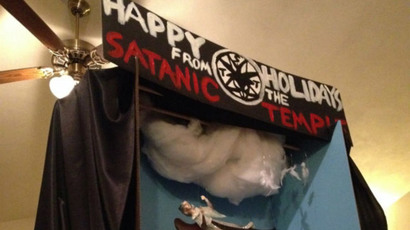Losing my religion: US population becomes less Christian

Christianity has experienced a sharp decline in Americans identifying as a member of that religion. Meanwhile, the number of people belonging to non-Christian faiths is growing, as is the number of unaffiliated people, according to a new report.
The number of people identifying as Christians in the US has dropped almost eight percentage points since 2007, from 78.4 percent to 70.6 percent, the Pew Research Center found in its 2014 Religious Landscape Study. At the same time, the number of unaffiliated Americans ‒ meaning atheists, agnostics and those who identify as “nothing in particular” ‒ increased more than six percentage points, from 4.7 percent in 2007 to 5.9 percent in 2014.

“What we’re seeing now is that the share of people who say religion is important to them is declining,” Greg Smith, associate director of research at the Pew Research Center, told the Washington Post. “The religiously unaffiliated are not just growing, but as they grow, they are becoming more secular.”
Americans are not as religiously insular as they once were. The poll found that among Americans who have gotten married since 2010, nearly four in 10 (39 percent) are in mixed-religion marriages, compared to 19 percent among those couples who got married before 1960.
"American religion is as caught up in change and innovation as any other part of American life," John C. Green, a political scientist who studies American religion at the University of Akron and who was an adviser to the study, told the Salt Lake Tribune. "That's not to say all are happy about it."
The United States' religious makeup is changing as people readily switch faiths and increasingly marry people from other traditions, he noted.
The so-called “millennial” generation is the most likely to be unaffiliated, as the median age of those who don’t identify with a faith is 36. The unaffiliated are becoming younger in general, as the median age of that group in 2007 was 38. While millennials are marrying later than their parents’ and grandparents’ generations did, they’re not becoming more religious as they age.
“Some have asked, ‘Might they become more religiously affiliated as they get older?’ There’s nothing in this data to suggest that’s what’s happening,” Smith said.
As the young become more secular, the median age of people belonging to Christian religions is going up. Half of all mainline Protestants are 52 or older, up from a median age of 50 in 2007. For Catholics, the median age grew from 45 to 49.
“There’s a continuing religious disaffiliation among older cohorts. That is really striking,” Smith said. “I continue to be struck by the pace at which the unaffiliated are growing.”

There are now about 56 million religiously unaffiliated adults in the US, up 19 million from 2007. Men are more likely to have left their sect than women.
“It’s remarkably widespread,” said Alan Cooperman, director of religion research for the Pew Research Center, according to the Washington Post. “The country is becoming less religious as a whole, and it’s happening across the board.”
As Christianity shrinks in the US, mainline Protestants and Catholics are those most likely to have left their faiths.
“That’s a striking and important note,” Smith said. “That means that there are more than six former Catholics for every convert to Catholicism. There’s no other group in the survey that has that ratio of loss due to religious switching.”

Along with secularism, non-Christian religions have seen increases in their ranks, albeit more modest gains. The overall non-Christian population increased from 4.7 percent in 2007 to 5.9 percent in 2014. About 8 percent of millennials identify as members of other faiths.
Islam had the largest increase among the non-Christian faiths, growing from 0.4 percent of the population to 0.9 percent, followed by Hinduism and other faiths that both had 0.3 percentage point increases. Hindus now comprise 0.7 percent of the US population, while 1.5 percent of Americans belong to other faiths ‒ meaning Unitarianism, New Age religions, Native American religions and others. The largest non-Christian faith in the US remains Judaism at 1.9 percent of the population.
As the number of religiously unaffiliated people increases, it may begin to impact the political landscape, not just the faith-based one. Secular people are more likely to vote for Democrats, while Christians, especially evangelical ones, make up the Republican Party’s religious right.
“That, in turn, means that arguments solely based on appeal to religious authority are not likely to carry the day. And remember, no one likes a scold,” the Washington Post’s Jennifer Rubin wrote in a Right Turn blog post.
Republicans need to recognize that others don’t have the same view of America as a Christian nation, and must make clear that there is a difference between their faith and their policy positions, she added.
Pew’s Religious Landscape Studies was “designed to fill the gap” between religious membership rolls that have no common criteria and general surveys of the US population that include only a few questions on faith. It also makes up for the fact that the US government doesn’t ask Americans about religion during its decennial census, so there are no official statistics on religion.
Pew surveyed more than 35,000 Americans between June and September, with a margin of error of plus or minus 0.6 percentage points. The forum compared its results with that of its 2007 survey to identify religious trends in the US.














